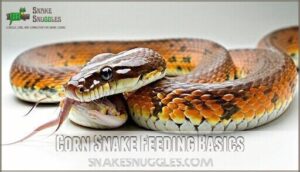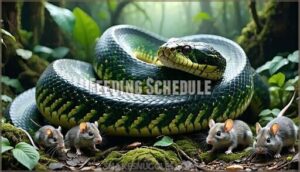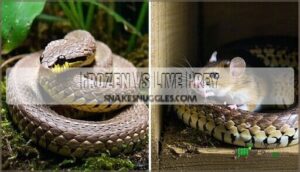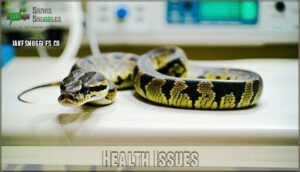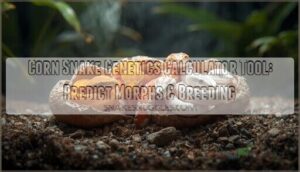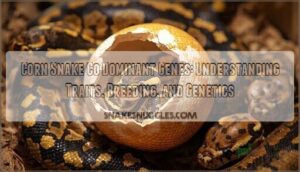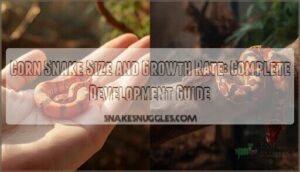This site is supported by our readers. We may earn a commission, at no cost to you, if you purchase through links.
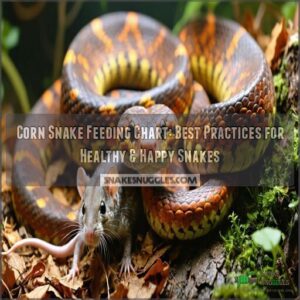
Hatchlings (0-3 months) need pinky mice every 5-7 days, juveniles (3-12 months) require fuzzy or hopper mice every 7-10 days, and adults (1+ years) should eat adult mice every 10-14 days.
The prey should be slightly wider than your snake’s widest body point—like fitting into a snug sweater.
Always offer thawed frozen prey for safety, and don’t handle your snake for 48 hours after feeding to prevent regurgitation.
Your snake might refuse food when shedding or during winter months—perfectly normal behavior for these otherwise enthusiastic eaters, and it’s essential to remember this to avoid unnecessary worry about your snake’s eating habits.
Table Of Contents
- Key Takeaways
- Corn Snake Feeding Basics
- Feeding Schedule
- Frozen Vs Live Prey
- Supplements
- Feeding Location & Water
- Reasons for Food Refusal
- Health Issues
- Frequently Asked Questions (FAQs)
- What can I feed my corn snake if I don’t have mice?
- Should I feed my corn snake 2 pinkies?
- How much prey should a corn snake eat?
- How do you feed corn snakes?
- When should you feed a corn snake?
- What is a healthy corn snake diet?
- How often do corn snakes eat mice?
- How do you know if a corn snake is healthy?
- How much do I feed my corn snake?
- How to tell if a corn snake is hungry?
- Conclusion
Key Takeaways
- You’ll need to adjust feeding frequency based on your snake’s age: hatchlings (0-3 months) need pinky mice every 5-7 days, juveniles (3-12 months) need fuzzy or hopper mice every 7-10 days, and adults (1+ years) need adult mice every 10-14 days.
- Your snake’s prey should be 1-1.5 times the width of its mid-body (like fitting into a snug sweater), and you should always use frozen-thawed prey instead of live prey to prevent injuries to your snake.
- Don’t be alarmed if your corn snake refuses food during shedding cycles (when eyes appear cloudy) or seasonal changes like winter brumation—these are normal behaviors that don’t require intervention.
- You should provide fresh, dechlorinated water daily in a sturdy bowl large enough for soaking, which helps maintain proper humidity levels and keeps your snake properly hydrated.
Corn Snake Feeding Basics
Feeding your corn snake the right way keeps it healthy and happy, so it’s important to offer the correct prey size and type.
Stick to whole, frozen-thawed rodents, and always match the prey size to your snake’s mid-body width for safe and easy digestion.
Prey Size
Getting the right prey size is vital for your corn snake’s health. Prey should match 1 to 1.5 times your snake’s ideal girth for safe digestion.
Here’s a simple size guide:
- Start hatchlings with pinky mice, advancing to hopper mouse size for juveniles, and adult mouse size for full-grown snakes.
Avoid power feeding or prey that’s oversized—a good rule of thumb is the bulge should barely show after feeding. Corn snake hatchlings often begin with small, easily digestible pinkies.
If one prey item is too small, try multiple prey while keeping the weight ratio in check.
Prey Types
In terms of feeding your corn snake, variety keeps it healthy and happy.
Rodents like mice and rats are staples, but introducing alternative prey can enhance both nutritional value and feeding enrichment.
Explore safe options like:
- Quail chicks: Tiny and packed with protein.
- Anoles: Nutritious, but make certain they’re captive-bred.
- Frozen mice or rats: Convenient and risk-free.
- Quail eggs: A treat for adventurous eaters.
Choose prey from reliable sources to guarantee safety.
It’s also important to prioritize captive-bred prey to avoid parasites.
Feeding Schedule
Feeding your corn snake on a proper schedule keeps it healthy and prevents overeating. Young snakes eat more often than adults, so adjusting the timing as they grow is important.
Frequency
A proper feeding schedule is key to keeping your snake active and healthy.
Feeding frequency depends on age and their metabolic rate:
- Hatchlings (8-20"): Feed every 5-7 days to match their fast growth.
- Juveniles (20-45"): Every 7-10 days as growth slows.
- Adults (35"+): Meals every 14-21 days work best.
Watch for seasonal adjustments like food refusal in colder months.
Use a corn snake feeding chart to track feeding intervals and tweak schedules as needed.
Overfeeding? Cut back—it avoids a chubby, slow snake.
Using frozen-thawed prey guarantees safety and quality.
Prey Size by Age
How often you feed your corn snake is important, but so is getting the prey size right—it’s the secret to keeping your snake happy and healthy.
A good feeding plan includes matching the prey to your snake’s age and size.
Here’s a simple guide from the corn snake feeding chart:
- Hatchlings (tiny noodles): One pinky mouse every 5-7 days. Their small size makes them the perfect fit.
- Juveniles: Move up to fuzzy mice or smaller hoppers weekly—time to grow!
- Subadults: Larger fuzzy mice or even multiple prey (like two smaller mice) every 7-10 days.
- Adults (the champs): A weaner rat or large mouse every 14 days—gradual, but satisfying.
Prey size should never exceed 1.5 times mid-body width. If the size bulge disappears in 24 hours, consider offering larger or multiple prey.
These tiny rodents are often sold as frozen reptile food.
Frozen Vs Live Prey
You’ve got a big decision to make regarding feeding your corn snake: frozen or live prey.
Feeding frozen/thawed is safer, easier, and more humane, while live prey can harm your snake if not handled correctly.
Frozen/Thawed Recommended
Frozen/thawed prey is the top choice for corn snake feeding, offering safety, convenience, and excellent nutritional retention.
Unlike live prey, it’s parasite-free and minimizes bacteria concerns.
Always thaw frozen prey safely: refrigerate overnight and warm in water to proper prey temperature.
This prevents refreezing dangers and guarantees easy digestion.
| Here’s a quick comparison of frozen mice benefits: | Aspect | Frozen/Thawed Benefits |
|---|---|---|
| Storage | Long-term freezer storage | |
| Safety | Parasite-free prey | |
| Nutrition | Retained quality nutrients | |
| Convenience | Always on hand | |
| Cost | Budget-friendly in bulk |
Proper thawing methods help keep your snake happy and healthy!
Avoid Live Prey
Feeding live prey could hurt your corn snake instead of helping it. Rodents defend themselves, leading to Injury Risks like bites or scratches. There’s also Parasite Transmission, Bacterial Infections, and Ethical Concerns about causing unnecessary suffering.
Frozen-thawed prey is safer, cleaner, and less stressful for your snake. It’s a win-win for snake feeding safety. One key advantage of frozen prey is that it eliminates the risks of rodent bites.
Here’s a quick look:
| Consideration | Live Prey | Frozen-Thawed Prey |
|---|---|---|
| Rodent Behavior | Bites or scratches occur | No chance of harm |
| Health Risk | Parasites, bacteria | Pre-screened, safer |
| Ease of Storage | Immediate care needed | Long-term freezing works |
Stick to frozen prey for happier, healthier snakes!
Supplements
Your corn snake mightn’t need supplements daily, but adding calcium or multivitamins occasionally can support healthy growth and shedding.
It’s like giving your snake a little extra boost to stay strong and vibrant.
Calcium & Multivitamin
A healthy corn snake diet needs the right supplements. Calcium and Vitamin D3 help strong bones and growth.
Dust prey lightly before feeding—don’t overdo it!
Follow these tips:
- Use calcium powder with D3 for ideal absorption.
- Stick to dosage guidelines based on your snake feeding chart.
- Supplement once every 2-4 meals.
- Choose reputable supplement brands for peace of mind.
Recommended Supplements
Supplements help your snake avoid nutritional deficiencies and improve overall health.
Use Repashy Calcium Plus LoD or Arcadia RevitaliseD3 to cover calcium and vitamin needs. Replace them every six months for freshness.
Keep prey gut-loaded and stick to dosage guidelines. When in doubt, ask a vet to make sure you’re on the right track.
- Recommended supplements: Repashy, Arcadia
- Useful tips: Rotate supplements, monitor health
Repashy products are available from various online retailers.
Feeding Location & Water
Feeding your corn snake in its enclosure keeps stress levels low and makes cleanup easier.
Always provide a clean water bowl with fresh water to keep your snake hydrated and happy.
Feed in Enclosure
Feeding your corn snake in its enclosure keeps things simple and stress-free while mimicking natural behavior.
For success, set up the space thoughtfully:
- Enclosure Size: Make certain ample room for your snake to move while feeding comfortably. A cramped space can create unnecessary stress.
- Hiding Spots: Add logs, plants, or hides to provide security, encouraging natural hunting instincts.
- Substrate Type: Use aspen or cypress mulch for clean-up ease and proper humidity control.
Stick to frozen mice to match your corn snake feeding chart, and pair these feeding tips with a consistent feeding schedule. Simple preparation equals happy, healthy feeding.
Water Bowl
Providing fresh water helps your corn snake stay healthy and avoid osmotic imbalance. A good water bowl also doubles as a humidity source.
Follow these tips:
- Bowl Size: Choose a heavy, sturdy bowl to prevent tipping. Make sure it’s big enough for soaking, as this aids humidity.
- Material: Use ceramic or glass bowls—they’re durable and easy to clean.
- Water Cleanliness: Replace the water daily with dechlorinated water and scrub weekly to avoid bacteria buildup.
- Placement: Put the bowl in a quiet, stress-free spot to encourage drinking and meet water requirements.
Healthy hydration guarantees a happy snake!
Reasons for Food Refusal
Sometimes your corn snake might refuse food, and it’s not always a cause for alarm.
Understanding common reasons like shedding, seasonal changes, or stress can help you address the issue with confidence.
Shed Cycle Impacts
When your corn snake shows cloudy eyes or dull skin, it’s likely shedding.
During this time, their shedding appetite drops, so don’t worry if they skip a meal.
Focus on their hydration needs and keep humidity levels right to ease their skin sensitivity.
These behavioral changes are normal, and your corn snake feeding chart can wait until their snake health is restored.
Seasonal Behavior Changes
As the seasons change, your corn snake’s appetite may shift.
During Winter Brumation, their metabolism slows, often causing a drop in hunger. Males sometimes skip meals in Breeding Season, while gravid females may refuse food while forming eggs.
- Cold or seasonal brumation reduces activity level, lowering the need for frequent feedings.
- Summer activity might briefly elevate appetite before shedding frequency adjusts.
Tweak your feeding schedule to match natural rhythms, ensuring peak health year-round.
Health and Stress
Feeding issues? Health and stress often play a role.
Obesity signs, improper humidity, or regurgitation causes like oversized meals can disrupt digestion and impact body condition.
Stress reduction is key—limit handling and make certain the enclosure feels safe.
Keep temperatures steady, water fresh, and prey size appropriate.
Digestive issues or health risks may also stem from parasites, so always practice parasite prevention.
A common reason for appetite loss can be incorrect thermal gradient.
If problems persist, consult a reptile veterinarian for expert veterinary care and peace of mind.
Health Issues
When food refusal continues beyond shedding cycles, health problems may be the culprit.
Snake regurgitation often signals underlying issues with digestion or husbandry problems.
Watch for these warning signs:
- Obesity signs: scales spreading apart, visible fat rolls, or labored movement
- Scale rot: discolored or raised scales with fluid underneath
- Metabolic bone disease: tremors, soft jaw, or difficulty moving
Snake metabolism slows during illness, making proper diagnosis vital.
If your corn snake shows breathing difficulties, weight loss despite eating, or unusual feces, it’s time to consult a reptile veterinarian.
Parasite prevention starts with clean enclosures and proper prey sources.
Never feed wild-caught animals as they often harbor dangerous parasites.
Regular health checks can catch problems early.
Remember, most snake digestion issues are preventable with proper temperature, humidity, and feeding practices.
Frequently Asked Questions (FAQs)
What can I feed my corn snake if I don’t have mice?
Like explorers finding alternate paths, you can feed your corn snake rats, chicks, quail, hamsters, gerbils, guinea pigs, or multimammate mice.
Always offer whole prey that’s captive-bred and properly sized for safety.
Should I feed my corn snake 2 pinkies?
Two pinkies can be appropriate if they match your corn snake’s size requirements (5x its widest body width).
This works when your snake is between feeder sizes, but don’t make it a regular habit.
How much prey should a corn snake eat?
As hungry as a wolf, your corn snake should eat prey that’s 1-5x its mid-body width or about 10% of its body weight.
You’ll want to feed appropriately sized mice or rats.
How do you feed corn snakes?
Feed your corn snake thawed frozen mice or rats using feeding tongs, not your fingers.
Offer prey that’s 5 times your snake’s mid-body width every 5-7 days for juveniles or 14-21 days for adults.
When should you feed a corn snake?
Hatchlings need meals every 5-7 days, juveniles every 7-10 days, and adults every 14-21 days. You’ll want to offer prey during daylight hours since corn snakes are naturally active then.
What is a healthy corn snake diet?
A healthy corn snake diet consists primarily of whole prey items like mice or rats.
You’ll need to feed your snake appropriately sized rodents every 5-7 days for juveniles and every 14-21 days for adults.
How often do corn snakes eat mice?
Like clockwork in a snake’s world, your corn snake’s feeding frequency varies by age.
Hatchlings eat every 5-7 days, juveniles every 7-10 days, and adults need mice only every 14-21 days.
How do you know if a corn snake is healthy?
A healthy corn snake has clear eyes, smooth skin, regular shedding, and steady weight. You’ll notice it’s active, alert, and breathes normally without discharge from the mouth or nose.
How much do I feed my corn snake?
Your corn snake’s meal size should be 1-5x its mid-body width or 10% of body weight.
Feed hatchlings every 5-7 days, juveniles every 7-10 days, and adults every 14-21 days using feeding tongs.
How to tell if a corn snake is hungry?
You’ll notice your corn snake actively exploring, tongue-flicking frequently, or staying alert near the enclosure door when hungry. They might also become more active during their regular feeding time.
Conclusion
Just as a well-charted course guides a ship safely to harbor, your corn snake feeding chart will steer you toward success.
Remember, proper prey sizing, consistent feeding schedules, and patience during non-feeding periods are your keys to a thriving snake.
By following these guidelines, you’ll develop confident feeding routines that support your corn snake’s health for years to come.
When in doubt, consult your vet—they’re your best partner in reptile care.

